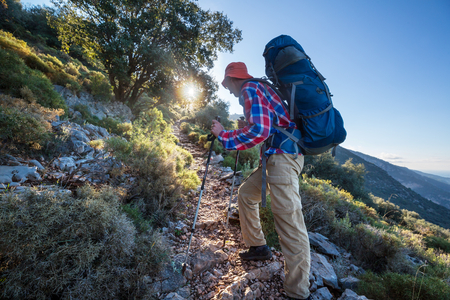1. Choosing the Right Footwear and Clothing
When it comes to family hiking, picking the right shoes and clothes is one of the most important steps for a safe and enjoyable experience. Here’s what you need to know to keep everyone comfortable on the trail.
Hiking Boots: What to Look For
A good pair of hiking boots makes all the difference. For both kids and adults, look for boots that offer ankle support, a sturdy sole for gripping uneven terrain, and are made from waterproof or water-resistant materials. Before hitting the trail, make sure everyone’s boots fit well—no pinching or slipping—and break them in with a few short walks around the neighborhood.
| Feature | Why It Matters | What To Check |
|---|---|---|
| Ankle Support | Prevents sprains and injuries on rocky trails | High-cut design with firm padding |
| Waterproofing | Keeps feet dry in wet grass or rain | GORE-TEX or similar membranes |
| Tread Pattern | Improves grip on slippery or loose surfaces | Deep, multi-directional lugs |
| Fit & Comfort | Avoids blisters and discomfort during long hikes | Enough toe room and snug heel fit |
The Importance of Moisture-Wicking Socks
Cotton socks might seem comfy, but they hold onto sweat and can cause blisters. Instead, pick moisture-wicking socks made from merino wool or synthetic blends. These keep feet dry by pulling sweat away from the skin and help regulate temperature, which is especially helpful for kids who might not notice hot spots until it’s too late.
Recommended Sock Materials:
- Merino Wool: Naturally odor-resistant and temperature-regulating.
- Synthetic Blends (like polyester): Lightweight and quick-drying.
- Avoid Cotton: Stays damp and causes friction.
Dressing for the Weather: Layering Basics
The weather can change quickly on the trail, so dressing in layers is key. Start with a moisture-wicking base layer, add an insulating layer like fleece if it’s chilly, and top it off with a windproof or waterproof jacket. For summer hikes, light-colored, breathable clothing helps keep everyone cool. Don’t forget hats for sun protection and lightweight gloves if it’s cold out.
| Layer Type | Main Purpose | Examples/Materials |
|---|
| Feature | Why It Matters |
|---|---|
| Padded Straps & Hip Belts | Reduce strain on shoulders and back |
| Multiple Compartments | Keeps gear organized and easy to find |
| Hydration Sleeve or Pockets | Makes it easy to carry water bottles or hydration bladders |
| Adjustable Fit | Ensures comfort as kids grow or for sharing between siblings |
| Reflective Details | Adds safety for early morning or evening hikes |
Packing Efficiently: What Goes Where?
Packing your backpack the right way makes a huge difference in how comfortable your hike feels. Heavier items (like water) should go close to your back and in the middle of the pack. Lighter things (like jackets or snacks) can go toward the top or outside pockets for quick access. Teach kids this trick so their own packs feel lighter!
Sample Packing Order:
- Bottom: Extra clothes or rain gear (soft, lightweight items)
- Middle (closest to back): Water, lunch, first aid kit (heaviest items)
- Top/Outside Pockets: Snacks, sunscreen, map (items you’ll want quickly)
Helping Kids Carry Their Own Gear Safely
If your children are old enough (usually around age 5+), let them carry their own small pack with a few essentials like a water bottle, snack, hat, or favorite toy. The American Hiking Society suggests that a child’s pack should weigh no more than 10-15% of their body weight. Keep it light and let them help choose what goes inside—that way they feel involved but not overloaded.
| Childs Weight | Max Pack Weight (10-15%) |
|---|---|
| 40 lbs (18 kg) | 4-6 lbs (1.8-2.7 kg) |
| 60 lbs (27 kg) | 6-9 lbs (2.7-4 kg) |
| 80 lbs (36 kg) | 8-12 lbs (3.6-5.4 kg) |
This approach keeps everyone happy on the trail—from tiny trekkers to seasoned hikers!

3. Essential Safety and Navigation Tools
When hiking as a family, being prepared with the right safety and navigation gear is just as important as packing snacks or water. Even on well-marked trails in popular U.S. national parks, unexpected things can happen. Here’s what every parent should have on hand to keep everyone safe and confident during your adventure.
Must-Have Safety and Navigation Items
| Item | Why Its Important | Family Hiking Tip |
|---|---|---|
| First Aid Kit | Treats scrapes, blisters, bug bites, or minor injuries fast. | Keep it stocked and teach kids how to use bandages safely. |
| Map (Paper) | Sometimes phones lose signal—maps always work. | Show your kids how to find your route and key landmarks. |
| Compass | A must-have backup for finding your way if you get turned around. | Let children practice pointing north—make it a fun game! |
| GPS Device | Great for tracking your location, especially on longer hikes. | Download offline maps before you hit the trail. |
| Whistle | Loud sound carries far in the woods if someone gets separated. | Give each child a whistle; teach them to blow three times if lost (“three blasts means help”). |
Teaching Kids Basic Trail Safety
- Stay Together: Remind kids that hiking is a team activity—no racing ahead or lagging behind.
- Trail Markers: Show them how to spot trail blazes or signs, and explain what they mean.
- If Lost: Teach the “Hug a Tree” principle—if they can’t see an adult, stop moving, stay put, and blow their whistle.
- No Shortcuts: Stick to marked trails. Shortcuts can lead to getting lost or damaging nature.
- Emergency Contacts: Make sure older kids know how to call 911 or park rangers if needed (and where to find emergency numbers).
Packing Checklist for Parents
- Pocket-sized first aid kit (with child-friendly supplies)
- Laminated paper map of the area
- User-friendly compass (practice at home!)
- Handheld GPS device or fully charged smartphone with offline maps
- A loud, brightly colored whistle for every family member
- ID bracelets for young children with your contact info
Your Role as Trail Leader
Your confidence in using these tools will reassure your kids and turn every hike into a fun learning experience. Practice navigation skills together before you go out, and let kids take turns leading short sections of easy trails under supervision. With the right gear and know-how, you’re set for memorable—and safe—family adventures outdoors!
4. Food, Water, and Snack Strategies
Hydration: Keep the Family Refreshed
Staying hydrated is crucial for everyone on the trail, especially kids who may not recognize thirst until theyre already dehydrated. Pack enough water for each family member—plan on at least 16-32 ounces per person for a short hike, and more for longer or hotter outings. Consider using hydration packs or sturdy reusable water bottles that fit easily in backpacks.
Water Packing Tips
| Family Member | Recommended Water Amount | Best Container Type |
|---|---|---|
| Toddler (under 5) | 8–16 oz (240–480 ml) | Sippy cup, small bottle |
| Child (5–12) | 16–32 oz (480–950 ml) | Lightweight water bottle |
| Teen/Adult | 32 oz+ (950 ml+) | Hydration bladder or large bottle |
Snack Smart: Healthy Energy on the Go
Packing the right snacks can keep spirits high and energy steady. Aim for a mix of protein, healthy fats, and carbs to help everyone power through the hike. Avoid sugary treats that can cause quick energy crashes. Trail mix, nut butter sandwiches, cheese sticks, fruit, and whole-grain crackers are all great picks for the trail.
Top Family-Friendly Hiking Snacks
| Snack Idea | Why It’s Great for Hiking |
|---|---|
| Trail Mix (nuts, seeds, dried fruit) | Packed with protein & energy; easy to share |
| Sliced Apples & Nut Butter Packs | Naturally sweet; offers fiber and protein boost |
| Cubed Cheese & Whole-Grain Crackers | Satisfying combo of carbs & calcium-rich dairy |
| Granola Bars (low sugar) | No-mess option; provides quick fuel when needed |
| Pretzels & Hummus Packs | Crispy and creamy textures; good source of plant-based protein |
| Squeeze Pouches (fruit/veggie blends) | Kid-friendly; convenient single servings without utensils needed |
Meal Planning: Simple Solutions for Longer Hikes
If your family adventure includes lunch or dinner on the trail, think about portable foods that are safe without refrigeration. Wraps with lean meats or hummus, cold pasta salads, hard-boiled eggs, and fresh veggies all pack well. Use insulated lunch bags with ice packs if you’re carrying perishable items.
Packing Tips for Meals:
- Pack individual portions in reusable containers to avoid spills.
- Avoid glass containers—they’re heavy and can break.
- Add wet wipes and extra napkins for easy cleanup.
Remember:
Smart planning for food and hydration means less stress during your hike—and helps everyone enjoy the adventure from start to finish!
5. Fun Extras and Creature Comforts
Making family hikes enjoyable isn’t just about having the basics covered. Bringing along a few fun extras can turn an ordinary walk in the woods into an exciting adventure for both kids and adults. Here are some great add-ons that can make your next hike memorable:
Fun Extras to Pack
| Item | Why It’s Awesome |
|---|---|
| Binoculars | Perfect for bird watching or spotting wildlife from a safe distance. Kids love getting a closer look at nature. |
| Field Guides | Handy little books or apps help identify plants, bugs, and animals. This turns your hike into a learning experience. |
| Bug Spray | Nothing ruins a good time like mosquito bites. Bring a kid-friendly repellent to keep everyone comfortable. |
| Sun Protection | Sunscreen, hats, and sunglasses are must-haves for keeping skin safe from harmful UV rays during sunny treks. |
| Pocket Games & Small Toys | A deck of cards, travel-sized games, or even a favorite stuffed animal can keep little ones entertained during breaks. |
Creature Comforts for Happy Hikers
- Portable Snacks: Bring easy-to-carry treats like trail mix, fruit snacks, or granola bars to keep energy levels up.
- Lightweight Blankets: Perfect for sitting down during rest stops or impromptu picnics.
- Pocket First Aid Kit: Scrapes happen! A small kit with band-aids and wipes gives peace of mind.
- Reusable Water Bottles: Keep everyone hydrated, especially on warm days.
- Tissues & Wet Wipes: Handy for messy hands, noses, or unexpected spills along the trail.
Tip: Get Kids Involved!
Let your kids pick one or two extras to bring. Giving them a choice—like which binoculars to use or which field guide to carry—can get them excited about the hike and help them feel responsible. With these little comforts and entertainment options, you’ll create positive memories and encourage a lifelong love of the outdoors—for the whole family!


